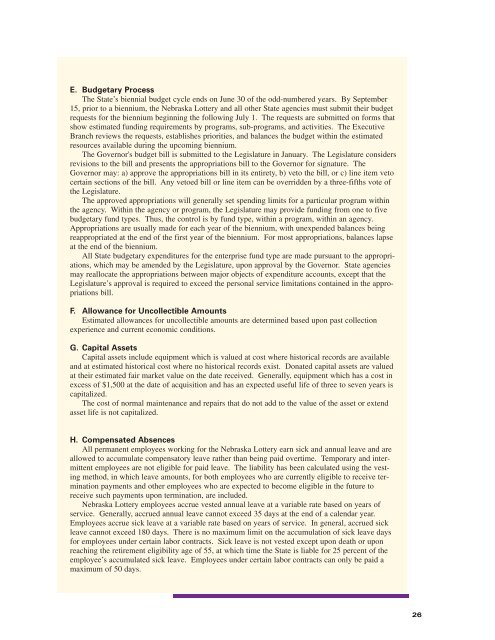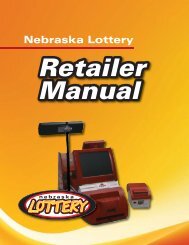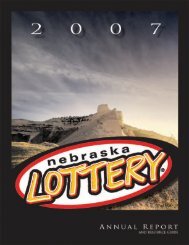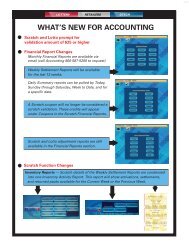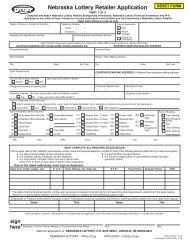Annual Report - Nebraska Lottery
Annual Report - Nebraska Lottery
Annual Report - Nebraska Lottery
You also want an ePaper? Increase the reach of your titles
YUMPU automatically turns print PDFs into web optimized ePapers that Google loves.
E. Budgetary Process<br />
The State’s biennial budget cycle ends on June 30 of the odd-numbered years. By September<br />
15, prior to a biennium, the <strong>Nebraska</strong> <strong>Lottery</strong> and all other State agencies must submit their budget<br />
requests for the biennium beginning the following July 1. The requests are submitted on forms that<br />
show estimated funding requirements by programs, sub-programs, and activities. The Executive<br />
Branch reviews the requests, establishes priorities, and balances the budget within the estimated<br />
resources available during the upcoming biennium.<br />
The Governor's budget bill is submitted to the Legislature in January. The Legislature considers<br />
revisions to the bill and presents the appropriations bill to the Governor for signature. The<br />
Governor may: a) approve the appropriations bill in its entirety, b) veto the bill, or c) line item veto<br />
certain sections of the bill. Any vetoed bill or line item can be overridden by a three-fifths vote of<br />
the Legislature.<br />
The approved appropriations will generally set spending limits for a particular program within<br />
the agency. Within the agency or program, the Legislature may provide funding from one to five<br />
budgetary fund types. Thus, the control is by fund type, within a program, within an agency.<br />
Appropriations are usually made for each year of the biennium, with unexpended balances being<br />
reappropriated at the end of the first year of the biennium. For most appropriations, balances lapse<br />
at the end of the biennium.<br />
All State budgetary expenditures for the enterprise fund type are made pursuant to the appropriations,<br />
which may be amended by the Legislature, upon approval by the Governor. State agencies<br />
may reallocate the appropriations between major objects of expenditure accounts, except that the<br />
Legislature’s approval is required to exceed the personal service limitations contained in the appropriations<br />
bill.<br />
F. Allowance for Uncollectible Amounts<br />
Estimated allowances for uncollectible amounts are determined based upon past collection<br />
experience and current economic conditions.<br />
G. Capital Assets<br />
Capital assets include equipment which is valued at cost where historical records are available<br />
and at estimated historical cost where no historical records exist. Donated capital assets are valued<br />
at their estimated fair market value on the date received. Generally, equipment which has a cost in<br />
excess of $1,500 at the date of acquisition and has an expected useful life of three to seven years is<br />
capitalized.<br />
The cost of normal maintenance and repairs that do not add to the value of the asset or extend<br />
asset life is not capitalized.<br />
H. Compensated Absences<br />
All permanent employees working for the <strong>Nebraska</strong> <strong>Lottery</strong> earn sick and annual leave and are<br />
allowed to accumulate compensatory leave rather than being paid overtime. Temporary and intermittent<br />
employees are not eligible for paid leave. The liability has been calculated using the vesting<br />
method, in which leave amounts, for both employees who are currently eligible to receive termination<br />
payments and other employees who are expected to become eligible in the future to<br />
receive such payments upon termination, are included.<br />
<strong>Nebraska</strong> <strong>Lottery</strong> employees accrue vested annual leave at a variable rate based on years of<br />
service. Generally, accrued annual leave cannot exceed 35 days at the end of a calendar year.<br />
Employees accrue sick leave at a variable rate based on years of service. In general, accrued sick<br />
leave cannot exceed 180 days. There is no maximum limit on the accumulation of sick leave days<br />
for employees under certain labor contracts. Sick leave is not vested except upon death or upon<br />
reaching the retirement eligibility age of 55, at which time the State is liable for 25 percent of the<br />
employee’s accumulated sick leave. Employees under certain labor contracts can only be paid a<br />
maximum of 50 days.<br />
26


